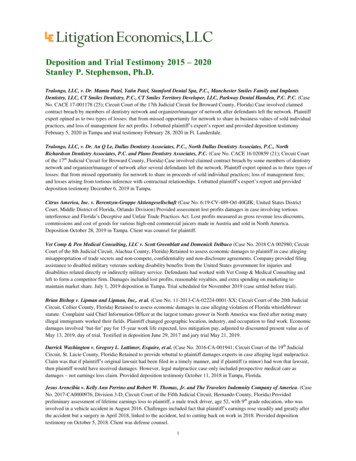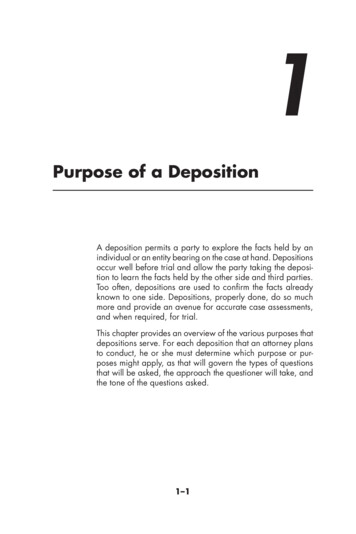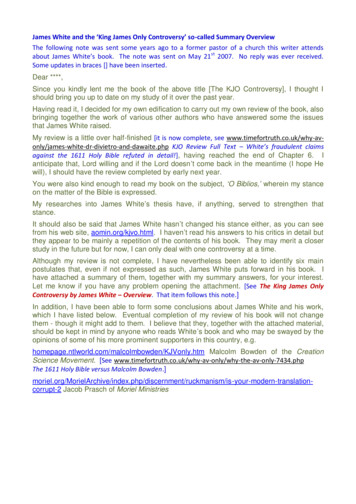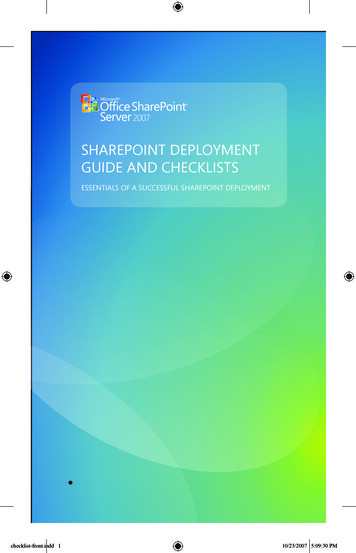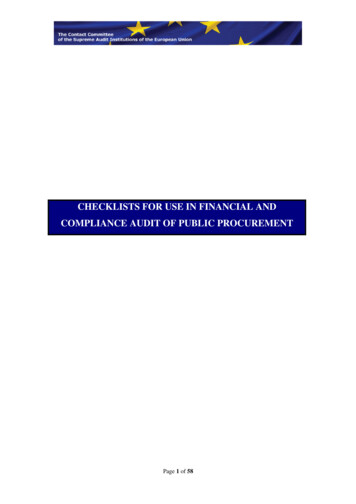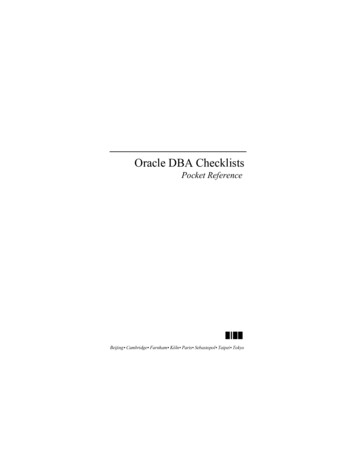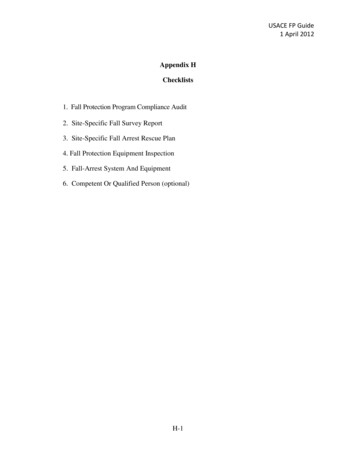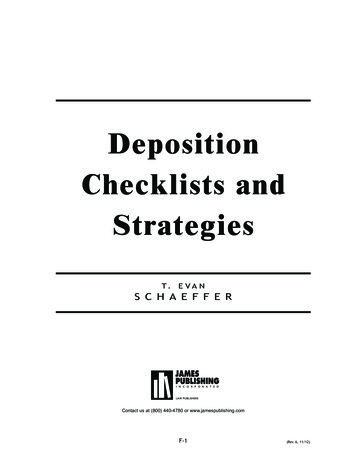
Transcription
DepositionChecklists andStrategiesT.E VA NS C H A E F F E RContact us at (800) 440-4780 or www.jamespublishing.comF-1(Rev. 6, 11/12)
Deposition Checklists and StrategiesF-2Copyright 2012James Publishing, Inc.ISBN: 1-58012-114-4All rights reserved.This publication is intended to provide accurate and authoritative information about the subject matter covered. It is sold with the understanding that the publisher does not render legal, accounting, or other professionalservices. If legal advice or other expert assistance is required, seek the services of a competent professional.Persons using this publication in dealing with specific legal matters should exercise their own independentjudgment and research original sources of authority and local court rules.The publisher and the author make no representations concerning the contents of this publication and disclaim any warranties of merchantability or fitness for a particular purpose.We view the publication of this work as the beginning of a dialogue with our readers. Periodic revisions toit will give us the opportunity to incorporate your suggested changes. Call us at (714) 755-5450 or send yourcomments to:Managing EditorJames Publishing, Inc.3505 Cadillac Ave., Suite HCosta Mesa, CA 92626www.jamespublishing.comFirst Edition, 12/06Revision 1, 12/07Revision 2, 12/08Revision 3, 11/09Revision 4, 11/10Revision 5, 12/11Revision 6, 11/12
F-3About the AuthorAbout the AuthorT. Evan Schaeffer is a 1990 magna cum laude graduate of St. LouisUniversity School of Law, where he was the Managing Editor of the St.Louis University Law Journal and received American JurisprudenceAwards in Contracts, Property and Evidence. Mr. Schaeffer is a member ofPhi Beta Kappa and the Order of the Woolsack.Mr. Schaeffer was admitted to the Missouri and Illinois bars in 1990.He began his career as a defense lawyer, but since 1996 has worked primarily on the plaintiffs’ side. Schaeffer’s areas of practice include complex commercial and tort litigation, including mass torts and classactions, as well as general civil litigation. He is a principal of Schaeffer& Lamere, P.C., based in the metropolitan St. Louis area.Mr. Schaeffer’s publications include articles and essays in many newspapers and magazines, including the Chicago Tribune, the Houston Chronicle, the St. Louis Post-Dispatch, and the Illinois Bar Journal. Mr. Schaeffer also publishes two weblogs, The Trial Practice Tips Weblog andBeyond the Underground, which together have received notice in manyprint publications, including the New York Times and The Economist.(Rev. 6, 11/12)
Deposition Checklists and StrategiesEditorial Advisory BoardLee H. AyresCook Yancey King & GallowayShreveport, LouisianaAlan K. GoldsteinGoldstein & PriceSt. Louis, MissouriLarry BendeskySaltz Mongeluzzi Barrett & BendeskyPhiladelphia, PennsylvaniaEric J. HolshouserCoffman Coleman Andrews & GroganJacksonville, FloridaWilliam H. FallonMiller JohnsonGrand Rapids, MichiganDerek R. LayserLayser & FreiwaldWestmont, New JerseyLeonard B. GabbayLeonard B. Gabbay, PCAustin, TexasRichard C. McCrea, Jr.Zinober & McCreaTampa, FloridaJoseph A. GalloWilson Elser Moskowitz Edelman & DickerNewark, New JerseyEric D. MillerMiller & MarkleAtlanta, GeorgiaPeter W. RileySchwebel Goetz & SiebenMinneapolis, MinnesotaEditorial StaffManaging Editor: Donna M. ColeEditor: Scilla BennettProduction: Amanda WinklerF-4
F-5Table of ContentsAbbreviated Table of ContentsChapter 1Deposition Procedures and StrategiesChapter 2Vehicular LiabilityChapter 3Premises LiabilityChapter 4Products LiabilityChapter 5Medical MalpracticeChapter 6Employment Discrimination and TerminationChapter 7Insurance Coverage DisputesChapter 8Consumer Protection and Deceptive Trade PracticesChapter 9Breach of ContractAppendix AOther Representative DepositionsIndex(Rev. 6, 11/12)
Deposition Checklists and StrategiesTable of ContentsChapter 1Deposition Procedures and StrategiesI.HOW TO USE THIS BOOKA. Chapter Organization§1:01 Overview of Substantive Law§1:02 Sample Deposition Outlines§1:03 A Note on ScopeB. Bonus Information§1:10 Practice Tips and Forms§1:11 Specialized Deposition Outlines§1:12 Practice Tips Relating to TrialII. PURPOSES AND USES OF DEPOSITIONSA. Depositions as§1:20§1:21§1:22a Discovery ToolThe Scope of DepositionsPurposes of DepositionsWhen You Shouldn’t Take a DepositionB. Depositions as a Settlement Tool§1:30 Using Depositions to Encourage Settlement§1:31 Practice Tip: Stay on the OffensiveC. Depositions as a Trial Tool§1:40 The Use of Depositions at TrialIII. PREPARING FOR DEPOSITIONSA. Depositions as§1:50§1:51§1:52Part of an Overall Discovery PlanReviewing the CaseEstablishing GoalsPreparing an Outline§1:52.1 Practice Tip: When Making a Deposition Outline, Should You WriteOut Every Question?§1:53 Practice Tip: Ten Things to Cover in Every DepositionB. Preparing the Documents§1:60 Choosing the Documents to Use§1:61 Preparing the DocumentsC. Other Pre-Deposition Tasks§1:70 Where to Conduct the Deposition§1:71 The Deposition Notice§1:72 The Court ReporterD. Some Special Situations§1:80 Telephone Depositions§1:81 Video Depositions§1:82 Second-Chairing Depositions§1:83 Practice Tip: Controlling Abusive Counsel With Video Depositions§1:84 Practice Tip: Use Exhibits Regularly During Video DepositionsF-6
F-7Table of ContentsIV. TYPICAL DEPOSITION PROCEDURESA. Starting Depositions§1:90 How to Begin a Deposition§1:91 Practice Tip: “The Usual Stipulations”§1:92 The Role of the Court Reporter§1:93 Practice Tip: Treating Court Reporters RightB. Questioning During Deposition§1:100 Preliminary Questions§1:101 Practice Tip: Always Ask the Standard Preliminary Questions§1:102 Practice Tip: Mixing It Up§1:103 Basic Questioning Technique§1:103.1 Practice Tip: Watch Out for Negatives in Leading Questions§1:103.2 Practice Tip: The Anatomy of the Perfect Deposition Question§1:104 Questions by Opposing CounselC. Ending Depositions§1:110 How to End a Deposition§1:111 Practice Tip: Can You “Wing It” at a Deposition?D. After the Deposition§1:120 Following Up on the Transcript§1:121 Practice Tip: Critiquing Your Own Performance§1:122 Practice Tip: Motions in Limine§1:123 Practice Tip: The Witness Can’t Outsmart You at a Deposition§1:124 Trial-Planning Steps to Take After a Deposition Has EndedV. OTHER DEPOSITION TECHNIQUESA. Handling Documents§1:130 Handling Documents at a Deposition§1:131 Practice Tip: “The Document Speaks for Itself”B. Situations You Might Encounter§1:140 The Uncooperative Witness§1:141 Practice Tip: Impeachment Nuggets§1:142 The Forgetful Witness§1:142.1 Practice Tip: Assume the Witness Is Lying§1:143 The Witness Who Talks Too Much§1:144 Practice Tip: Asking Follow-Up Questions§1:145 The Witness Who Talks Too Little§1:145.1 The Witness Who Answers “I Don’t Know”§1:146 The Difficult Opposing Counsel§1:147 Practice Tip: How to Spot Liars—Ask for the Story in ReverseVI. OBJECTIONS AT DEPOSITIONSA. Handling Objections§1:160 Handling Objections: Overview§1:161 Ignoring the Objection§1:162 Asking for the Basis of an Objection§1:163 Rephrasing the Question§1:164 Seeking Judicial Intervention§1:165 How Deposition Objections Are Ruled on Before Trial(Rev. 6, 11/12)
Deposition Checklists and StrategiesF-8B. Types of Objections§1:170 Objections to Form§1:170.1 Practice Tip: Leading Questions in Federal-Court Depositions§1:171 Objections to Foundation§1:172 Objections Relating to Relevancy§1:173 Objections Based on Privilege§1:174 Other Objections§1:175 Practice Tip: Speaking Objections and How to Stop ThemVII. EXPERT DEPOSITIONSA. Before the Deposition§1:180 Written Discovery of Defense Expert Opinions§1:181 Sample OutlinesB. Goals of 1:196§1:197DepositionsOverviewDiscover Every Opinion of the Opposing ExpertDiscover the Factual Basis for All OpinionsPractice Tip: Attempting to Strike the ExpertLearn About the Opposing Expert’s QualificationsObtain Admissions to Use to Support Your CaseExplore All Sources of BiasLay a Foundation for Your Demonstrative EvidenceC. How to Prepare for Expert Depositions§1:210 Overview§1:211 Reviewing the File§1:212 Practice Tip: Review the Pattern Jury Instructions§1:213 Gathering the Key Documents§1:214 Familiarize Yourself With Government Standards§1:215 Studying the Expert’s CV and Report§1:216 Practice Tip: Five Ways to Hit Home Runs With an Expert’s CV§1:216.1 Practice Tip: Pay Attention to the Dates on the Expert’s CV§1:217 Conducting Other Research About the Expert§1:217.1 Practice Tip: Preparing for Expert Depositions by Looking Ahead tothe Cross-Examination at Trial§1:218 Consult With Your Own Expert§1:219 Practice Tip: Privilege and ExpertsD. Expert Deposition Strategies§1:230 Using Texts in the Deposition§1:231 Questioning Techniques§1:232 Practice Tip: “Why Is That?” and Other Follow-Up Questions That Never Fail§1:232.1 Practice Tip: The Use in Depositions of Tone of Voiceand Body Language§1:233 Should You Cross-Examine the Expert During His Deposition?§1:234 Caution: Time Limits on Depositions§1:235 Practice Tip: What to Do When You Arrive for an Expert’s Deposition§1:236 Practice Tip: What to Do When the Defendant Buries You With Experts§1:237 Other Practice Tips Elsewhere in the Book
F-9Table of ContentsVIII.ADVANCED DEPOSITION TECHNIQUESA. Managing the Witness§1:250 Get the Witness Acting Like a Normal Person§1:251 Make the Witness Feel at Home§1:251.1 Practice Tip: Improve Your Deposition Technique by ReviewingYour Transcripts§1:252 Make Sure You Get the Real Answer§1:253 Know When to Give Up§1:254 Practice Tip: How to Cross-Examine at Trial With Inconsistent StatementsB. Asserting Control Over the Witness§1:260 Assert Your Right to Ask Questions§1:261 Control the Order of the Questioning§1:262 Control the Speed of the Questioning§1:262.1 Practice Tip: Asserting Control With the “Unresponsive” Objection§1:263 Be Confident About Your Abilities§1:264 Practice Tip: Make Your Depositions ShorterIX. FURTHER AIDS FOR READING AND NAVIGATING THE BOOKA. Focusing on Particular Aspects of Deposition Practice§1:270 How to Personalize the Book to Improve Your DepositionsB. Navigating the Book’s Practice Tips§1:280 Practice Tips Organized by ThemeChapter 2Vehicular LiabilityI.ELEMENTS OF THE PLAINTIFF’S CAUSE OF ACTIONA. Theories of Recovery§2:01 Overview§2:02 The Elements of Negligence, as Applied to Vehicular Liability§2:03 Practice Tip: Read Your State’s Model Jury Instructions§2:04 Common Fact Patterns§2:05 Practice Tip: Don’t Overlook Potential Defendants§2:06 Practice Tip: Know the Statutory Law of Your StateB. Typical Defenses in a Vehicular-Liability Case§2:20 Contributory or Comparative Negligence§2:21 Other Negligence-Based Defenses§2:22 Practice Tip: Discover and Attack the Facts Upon Which the Defense Is BasedII. THE DISCOVERY PLANA. The §2:37and Timing of DiscoveryThe Initial Round of Written DiscoveryCaution: Never Overlook the Importance of InsuranceRequest for AdmissionsPractice Tip: Inspect the ScenePractice Tip: Secure the Automobile if It Is a Total LossDepositionsWritten Discovery of the Opinions of Defendant’s ExpertsPractice Tip: Consult With Your Client’s Doctor(Rev. 6, 11/12)
Deposition Checklists and StrategiesB. Documents and§2:50§2:51§2:52§2:53Exhibits in a Vehicular-Liability CaseDocuments and Exhibits: OverviewLiability DocumentsDamage DocumentsPractice Tip: Take Your Client to DepositionsC. Typical Deponents in a Vehicular-Liability Case§2:60 Typical Deponents: Overview§2:61 Occurrence Witnesses§2:62 Practice Tip: Learn to Do Informal Discovery§2:63 Medical Witnesses§2:64 Other Witnesses Regarding Damages§2:65 Practice Tip: Abstract Depositions as You Go§2:66 Defendant’s Expert Witnesses§2:67 The Depositions the Defendant Will Take§2:68 Practice Tip: How to Use Experts in an Auto CaseIII. DEPOSITION #1: DEFENDANT-DRIVERA. Setting the Stage§2:80 Overview§2:81 TimingB. Deposition Goals, Strategy, Preparation, and Exhibits§2:90 Deposition Goals§2:91 Deposition Strategy§2:92 Deposition Preparation§2:93 Deposition ExhibitsC. The Deposition Outline1. Background Facts and Thumbnail Outline§2:100 Background Facts§2:101 Thumbnail Outline/Deposition Checklist2. Preliminary Questions§2:110 Standard Introductory Questions§2:111 The Witness’s Background§2:112 The Witness’s Preparation for the Deposition§2:113 The Witness’s Relationship to Other Parties and Witnesses§2:114 Practice Tip: Putting the Witness at Ease3. The Collision§2:120 Part I: Events Leading Up to the Collision§2:121 Part II: Central Events§2:122 Part III: After the Collision§2:123 Practice Tip: Driving Experience and Licensure4. Defendant’s Condition on Day of Collision§2:130 Defendant’s Activities on the Day of the Collision§2:131 Practice Tip: Estimates of Times§2:132 Practice Tip: Establishing Fatigue§2:133 Alcohol and Drugs5. The Vehicles§2:140 Condition of the Deponent’s Vehicle Before the Collision§2:141 Condition of the Vehicles After the Collision§2:142 Practice Tip: Lack of Damage as Evidence of Negligible ForceF-10
F-11Table of Contents6. Traffic Tickets and Plaintiff’s Negligence§2:150 Traffic Tickets§2:151 Plaintiff’s Contributory Negligence7. Admissions, Witnesses, and Statements§2:160 Admissions§2:161 All Witnesses to the Occurrence§2:162 Knowledge of Conversations§2:163 Formal Statements§2:164 Informal Statements and Interviews§2:165 Conversations About the Accident or the Lawsuit8. Closing§2:170 Photographs and Diagrams§2:171 Closing QuestionsIV. DEPOSITION #2: POLICE OFFICER WHO DID THE ACCIDENT REPORTA. Setting the Stage§2:180 Overview§2:181 TimingB. Deposition Goals, Preparation, and Exhibits§2:190 Deposition Goals§2:191 Deposition Preparation§2:192 Deposition ExhibitsC. The Deposition Outline1. Background Facts and Thumbnail Outline§2:200 Background Facts§2:201 Thumbnail Outline/Deposition Checklist2. Preliminary Questions§2:210 Standard Introductory Questions§2:211 The Witnes
Awards in Contracts, Property and Evidence. Mr. Schaeffer is a member of Phi Beta Kappa and the Order of the Woolsack. Mr. Schaeffer was admitted to the Missouri and Illinois bars in 1990. He began his career as a defense lawyer, but since 1996 has worked pri-marily on the plaintiffs’ side. Schaeffer’s areas of practice include com-plex commercial and tort litigation, including mass torts .
